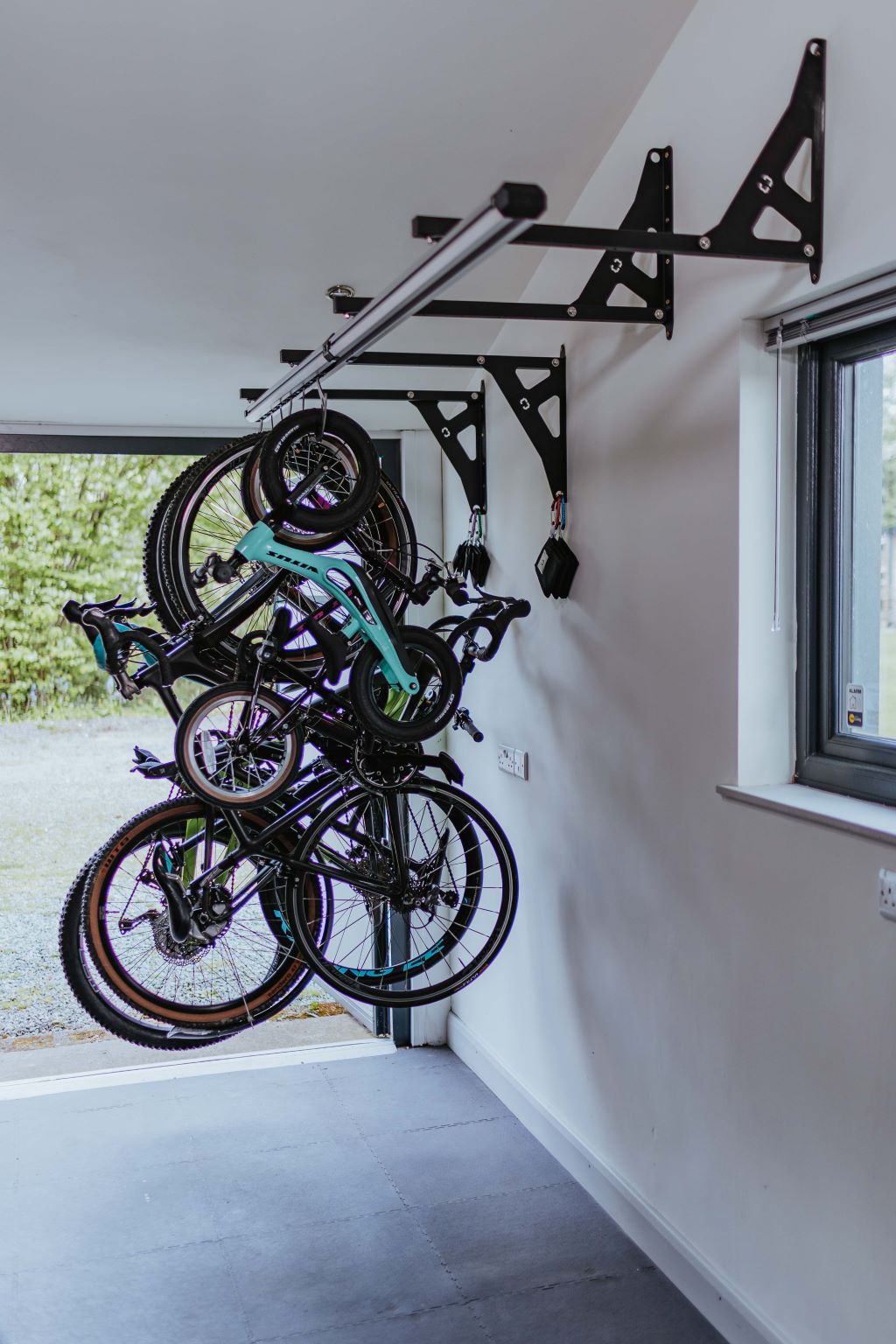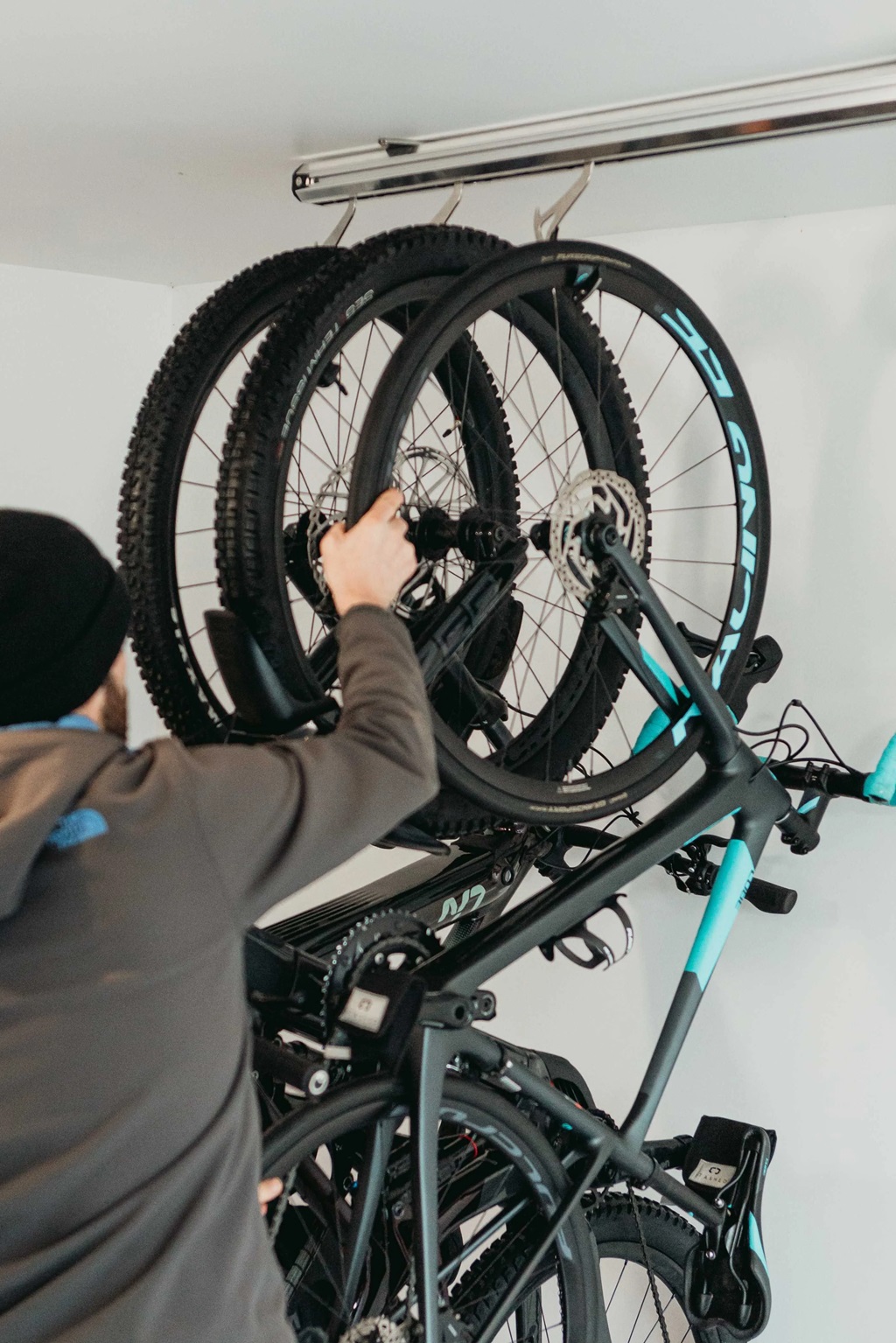Establishing a dedicated storage area for your bicycle at home is essential for ensuring its security, maintaining organization, and preventing clutter. Wall mounted bike racks serve as an excellent storage solution by enabling you to vertically suspend your bikes on any wall. This not only maximizes floor space but also contributes to the cleanliness of your bike, as it is elevated from the ground and less prone to accumulating dust. Wall-mounted racks are a practical and space-efficient means of safeguarding your bicycle while keeping it easily accessible for regular use.
Benefits of Wall Mounted Bike Racks
Wall mounted bike racks offer several advantages over other storage options:
Save Floor Space
Storing bikes vertically clears up floor areas that would otherwise be occupied by kickstands or bike stands. This creates open space that can be used for other purposes.
Keep Bikes Accessible
Unlike shed or garage storage, hanging bikes on the wall keeps them easily accessible when needed. No more dragging bikes in and out of crowded storage areas.
Prevent Damage and Dirt
Elevating bikes off the ground protects them from accidental bumps and scratches. It also keeps bike chains, gears, and frames cleaner without sitting on dirty garage floors.
Organized Storage
Wall mounted racks allow for neat, orderly bike storage. Bikes can be lined up evenly and out of the way.
Versatile Mounting
Bike racks can be mounted on any wall studs, which provides flexibility for storage locations. Garage, patio, apartment – wall-mounted racks can be placed wherever there is vertical wall space.
Security
Bikes are more secure when inside locked homes rather than in open carports or backyard sheds. Wall mounting also makes it harder for bikes to be stolen off the rack since they can’t easily be lifted off.
Aesthetic Appeal
Wall mounted bike racks prevent clutter and look much tidier than leaning bikes or overcrowded floor racks. Highlight your bikes as functional art instead of messy pile-ups.
Considerations When Choosing a Wall Mounted Bike Rack
While wall mounted bike racks make storage easy and convenient, there are a few factors to consider so you select the right one for your needs:
Weight Capacity
Determine the total weight of the bikes you’ll be storing. Make sure to choose a rack with a weight capacity that exceeds the cumulative bike weight. Standard racks hold 2-3 bikes of average weight, but heavier duty racks are available for mounting multiple or heavier bikes.
Materials
Racks come in a range of durable materials like steel, aluminum and carbon fiber. Consider factors like weight, strength, and resistance to rust and corrosion. Steel is affordable and strong, while aluminum is lighter but still sturdy. Carbon fiber is lightweight yet extremely tough.
Mounting Style
Key mounting options include:
- Wall brackets – Basic brackets secure racks directly into studs or drywall anchors. Offer the most flexibility for positioning racks.
- Ceiling mount – Good for high ceilings, these mount racks to ceiling joists with long poles that extend down to the desired bike height.
- Freestanding – Freestanding racks lean back against the wall without fasteners. Easy to reposition but less secure.
Adjustability
Look for racks with adjustable arms that can fit different bike frames and tires. Vertical adjustability is also useful to accommodate bikes of different heights and sizes.
Protection
Padded clamps and rail covers shield bike frames from scratches and damage during storage. Useful for preserving bike paint jobs.
Accessories
Some racks include integrated locks, additional hooks or racks for gear storage, and tire trays to prevent floor scuffs. Determine if any add-ons would be helpful for your space.
Price
Like most things, you get what you pay for in terms of durability, features and capacity. However, quality wall racks are available across a range of budgets. Set realistic expectations based on price points when making purchasing decisions.
Wall Mounted Bike Rack Styles
There are several common design styles to choose from when selecting a wall mounted bike rack. Consider your space, budget and usage to pick the right rack style for your needs.
Basic Wall Hooks
Simple metal hooks that screw into studs are an affordable and minimalist storage solution. They keep bikes out of the way and open up floor space. Hooks allow bikes to hang freely and swing side to side.
Pros
- Inexpensive
- Easy installation
- Compact size
Cons
- Limited support and security
- Increased risk of bike damage
- Difficult to properly align multiple bikes
Vertical Bike Racks
Vertical wall racks provide dedicated spaces to store each bike upright in an organized fashion. Arms, clamps and braces fully secure and support bike frames. Vertical racks maximize wall storage space.
Pros
- Organized storage
- Even weight distribution
- Increased bike security
- Allow handlebar turning for compact storage
Cons
- Require stud mounting
- Improper installation can risk bike damage
- Often only fits 2-3 bikes
Ceiling Mounted Hoist Systems
Hoist systems use long poles to suspend bikes from the ceiling and lift them up and out of the way. The pole height is adjustable to raise bikes as high as the ceiling allows. Systems include pulleys for easy lifting and lowering.
Pros
- Great for high/vaulted ceilings
- Completely frees up floor space
- Allows access to bikes without removing them
Cons
- Cannot be used on standard height ceilings
- More difficult installation
- Higher cost than other options
Freestanding Wall Racks
Freestanding racks lean back against the wall without permanent mounting. They stay upright under the bike’s weight. Offers flexibility to move and reposition the rack as needed.
Pros
- No wall modifications needed
- Can be relocated easily
- Often adjustable sizing
Cons
- Less secure than mounted racks
- Can tip or fall over if bumped
- Weight limitations for safety
Multi-Level Racks
These specialized racks allow vertical bike storage on multiple levels, essentially doubling or tripling storage. Levels are connected by side poles that absorb weight.
Pros
- Increased storage capacity
- Organized stacking
- Reduce side-to-side space needed
Cons
- Often fixed adjustments
- Require very sturdy anchoring
- Difficult to mount more than 2-3 levels
Installation Tips for Wall Mounted Bike Racks
Proper installation goes a long way in keeping your wall mounted bike rack secure and safe to use. Follow these tips when installing any style of wall mounted bike rack:
Find Wall Studs
Bike racks need to be screwed firmly into wall studs, not just drywall. Use a stud finder to locate studs before marking holes. If possible, position rack arms directly aligned with studs.
Follow Included Instructions
Carefully read and follow all installation directions included with the rack. Each style and model with have specific steps and hardware. Refer to instructions for weight capacities and anchor requirements.
Use Appropriate Fasteners
Most racks include fasteners, but you may need supplemental hardware like wall anchors for added support. Always use screws and bolts suitable for the rack’s weight capacity and your wall type.
Level Installation
Use a level tool to ensure rack is mounted evenly. Double check that all arms and parts align horizontally so bikes don’t tip sideways or twist when mounted.
Test Weight Bearing
Once installed, gently test rack integrity by applying light pressure similar to weighted bikes before fully loading it. Test weight bearing and inspect joinery for any slipping.
Adjust Fittings
Adjust clamps, braces and arms to properly fit bike frame sizes and shapes after mounting the rack itself. Test fitting with one bike before storing full fleet.
Inspect Regularly
Periodically inspect the rack for stability and loose joinery that could develop over time. Look for signs of twisting or pulling that might indicate a weak point needing reinforcement.
Bike Storage Tips and Maintenance
Keep your bikes in top shape while stored on wall racks with these maintenance tips:
Use Stabilizer Bar
Bike stabilizer bars connect front forks to prevent steering and keep handlebars straight – ideal for vertical storage. Keeps handlebars from turning and hitting adjacent walls or bikes.
Avoid Overloading
Do not exceed the rack’s weight limits. Overloading risks pulling it from the wall or breaking components. Heavier bikes like E-bikes should be stored centrally to disperse weight evenly.
Protect Walls and Bikes
Install bumpers on rack arms to protect bike paint. Hang foam pads or old tubes on walls behind bikes to prevent scratches if handlebars turn.
Lock It Up
Use bike locks or integrated locking systems to secure bikes on racks and prevent theft. Locking hangs prevents anyone from lifting bikes off.
Clean and Lube
Wipe down bike frames to remove dust and dirt accumulated during storage. Lubricate chains and gears to prevent rusting. Spin wheels periodically.
Monitor Tire Pressure
Check tire pressure monthly and refill as needed. Letting tires deflate while stored can damage wheels long term.
Bring Inside During Storms
If possible, it’s best to bring stored bikes indoors during severe storms, heavy winds or winters in cold climates. Prolonged outdoor exposure can damage components.
Proper installation and care will ensure your wall mounted bike rack provides reliable, long-lasting and safe vertical bike storage for years to come! Clear up clutter while keeping your bikes secure, clean and easily accessible.
Frequently Asked Questions
What types of walls can bike racks be mounted on?
Wall mounted bike racks can be installed on any common interior wall material – drywall, brick, concrete, etc. The key is anchoring into the wall studs or utilizing heavy-duty wall anchors if between studs. Exterior walls need proper weather protection.
How much weight can wall mounted racks hold?
General load capacity is 30-75 lbs per bike position, but heavy duty racks are available that can handle 100+ lbs per bike to accommodate electric bikes. Make sure the combined bike weight does not exceed rack limits.
How far apart should bike rack arms be spaced?
Arms should be spaced at least 24-30 inches apart to allow room for bike handles and prevent interference between adjacent bikes. Narrow 16-20 inch spacing can work for lightweight bikes with narrowed handlebars.
Can wall bike racks be installed vertically or horizontally?
Vertical installation utilizes wall height most efficiently. Horizontal mounting is possible but takes up much more wall space. Vertical hanging puts less side torque on racks and anchor points.
What is the best height to install wall mounted bike racks?
Standard installation height is 5-6 feet from floor to bottom hook of rack. This provides enough clearance to walk past bikes without hitting heads. Higher mounting like 7-8 feet can work for high ceilings.
Conclusion
Wall mounted bike racks maximize available space by storing bikes vertically and out of the way. Hanging bikes keeps them easily accessible yet secure, clean and protected. When contemplating the items for decorating a house, it’s essential to integrate practical solutions into the aesthetic vision; for instance, wall racks with appropriate weight capacities and smart mounting not only enhance the decor but also offer an excellent storage solution tailored to your space, budget, and specific needs, be it for displaying decorative items or organizing essentials in any home, apartment, or garage. With proper installation and ongoing bike care, wall mounted racks will serve you well for many years of organized bike storage.







